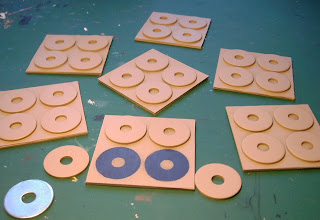Played a small Shieldwall game using the new WAB 2nd Edition rules today at the Edgewood Bunker with Adrian. We scaled back our Norman armies to 1,000 points each, more or less. Probably had too much of a percentage of mercenaries, but we went with what we had. Adrian used an all cavalry army consisting of a unit each of Norman Milites, Devroet with throwing spear and javelins, and a Pueri light cav unit. His Milites and Devroet are both 16 figure units - all on warhorses to boot! He made these unit extra-large to counter a Welsh army that Dan P. has - so Dan's unit wouldn't outnumber his two-to-one in combat for the FBIGO option. It was one of their early WAB armies, and I think Adrian is going to reconfigure his. My army was a Milite cav unit of 12 figures with lances, a 10 figure Pueri unit and three mercenary Dogs of War units. The mercs consisting of one unit each of bowmen, crossbowmen, and footmen with double-handed axes. I'd rather have had javelinmen and spearmen instead of the crossbowmen and axemen, but didn't have any at the moment.
This is a shot of my forces after the opening moves:
The shot below is after the charge of Devroet being declared on the crossbowmen who chose to flee - they were too close to fire and flee. The Devroet ended up charging into the merc axemen. The resulting combat was a tie, with a musician roll off. The Serjeants' musician won the momentum point, and they also redressed their ranks. Sadly, they lost the next round, quite badly, and was reduced to less than five figures - actually only one, who fled off the table.

Things were a lot better on the other side of the battle. My Pueri and merc bowmen did well enough to scare off Adrians Pueri. He later attempted to charge my Pueri with his Milites, but they wisely fled out of range of the charge. However, his Milites ended up within reach of my Milites who charged them. They counter charged, but eventually lost the round of combat. They chose to flee, but I overran them. His Comes was in the unit and that ended the game in the middle of Turn 5. We had decided to end at this turn at the beginning of the game anyway.


All in all it was a relaxed game, looking up some of the new changes to the rules and discussing them - like the musician roll off to decide momentum, but not actually winning the combat. Hopefully, we can play a game a month until we're comfortable with the new rules - although Adrian has a busy schedule. We also talked about what we could host at next year's
Enfilade! - the local biggie historical convention here in the Pacific Northwest. We might even do a "Last Samurai" with modified Sharp Practice rules. I have to find that Dixon Samurai I have and lop off his head then attach a Victrix head onto it for Tom Cruise.



















































